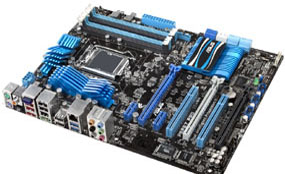Asus Unveils Motherboards Based On Next Gen Intel Chipsets
Asus held a tech seminar over the weekend in which it discussed future product launches, new features, and its plans for the year 2011. We've got information on the four new motherboards Asus is launching to support Intel's upcoming Sandy Bridge. Fans of Asus who are also interested in upgrading when Sandy Bridge drops, will find the below of particular interest.
From the top left corner we've got the Asus P8P67 Pro, the P8P67 Deluxe, the Maximus IV Extreme (bottom left) and the Sabertooth 3D (bottom right.) We visually compared the Pro and Deluxe—the Deluxe offers at least one more fan connector, more backplate USB ports, a BIOS output code display, and board-mounted buttons to control power, reset, etc. The Deluxe version also has a second, heatpiped heatsink—but if you compare the two boards, it's not at all clear what the heatsink *does.* We can safely assume that the Pro's smaller heatsink is sufficient to cool the board on its own. A second heatpiped heatsink offers a bit more room for overclocking or higher temperatures, but Asus would do better to simply slap a well-made small fan on the existing structure.
There's one potential flaw to the Deluxe that the pro doesn't have. If you check the board photo, the first PCIe x1 slot is hard against the second heatsink. We've seen this problem before on other high-end boards—any x1 card that doesn't vertically conform to the actual size of the slot may not fit. This issue isn't unique to Asus, we've seen other high-end boards whose heatsinks prevent anything but the smallest x1 cards from fitting.
The Maximus IV is an imposing beast of a motherboard with four full PCIe x16 slots, one x1 slot, and an actual x4 slot at the bottom. That last is a nice feature for anyone interested in a PCIe storage device like the OCZ RevoDrive or RevoDrive X2. Finally, there's the Sabertooth. If Asus' intention was to build a board that left everyone staring, they've succeeded. The problem here is that we've got no idea what we're actually staring at. The Sabertooth's backpanel offers features more-or-less in line with the other boards discussed above, but it offers just two PCIe x16 slots and three PCIe x1 slots. Supposedly this is a product designed for high reliability and durability. We're great fans of both, but we're uncertain what Asus' design actually protects. Unless the area under the board is specially ventilated via its own unseen fan, the components underneath the board will bake. This is particularly true of the southbridge, which is apparently flush with the sides of the...flak jacket.
We expect to see more and more announcements from motherboard manufacturers in the coming weeks; stay tuned for further coverage on who's offering the best price/performance/feature ratio.
From the top left corner we've got the Asus P8P67 Pro, the P8P67 Deluxe, the Maximus IV Extreme (bottom left) and the Sabertooth 3D (bottom right.) We visually compared the Pro and Deluxe—the Deluxe offers at least one more fan connector, more backplate USB ports, a BIOS output code display, and board-mounted buttons to control power, reset, etc. The Deluxe version also has a second, heatpiped heatsink—but if you compare the two boards, it's not at all clear what the heatsink *does.* We can safely assume that the Pro's smaller heatsink is sufficient to cool the board on its own. A second heatpiped heatsink offers a bit more room for overclocking or higher temperatures, but Asus would do better to simply slap a well-made small fan on the existing structure.
There's one potential flaw to the Deluxe that the pro doesn't have. If you check the board photo, the first PCIe x1 slot is hard against the second heatsink. We've seen this problem before on other high-end boards—any x1 card that doesn't vertically conform to the actual size of the slot may not fit. This issue isn't unique to Asus, we've seen other high-end boards whose heatsinks prevent anything but the smallest x1 cards from fitting.
The Maximus IV is an imposing beast of a motherboard with four full PCIe x16 slots, one x1 slot, and an actual x4 slot at the bottom. That last is a nice feature for anyone interested in a PCIe storage device like the OCZ RevoDrive or RevoDrive X2. Finally, there's the Sabertooth. If Asus' intention was to build a board that left everyone staring, they've succeeded. The problem here is that we've got no idea what we're actually staring at. The Sabertooth's backpanel offers features more-or-less in line with the other boards discussed above, but it offers just two PCIe x16 slots and three PCIe x1 slots. Supposedly this is a product designed for high reliability and durability. We're great fans of both, but we're uncertain what Asus' design actually protects. Unless the area under the board is specially ventilated via its own unseen fan, the components underneath the board will bake. This is particularly true of the southbridge, which is apparently flush with the sides of the...flak jacket.
We expect to see more and more announcements from motherboard manufacturers in the coming weeks; stay tuned for further coverage on who's offering the best price/performance/feature ratio.





